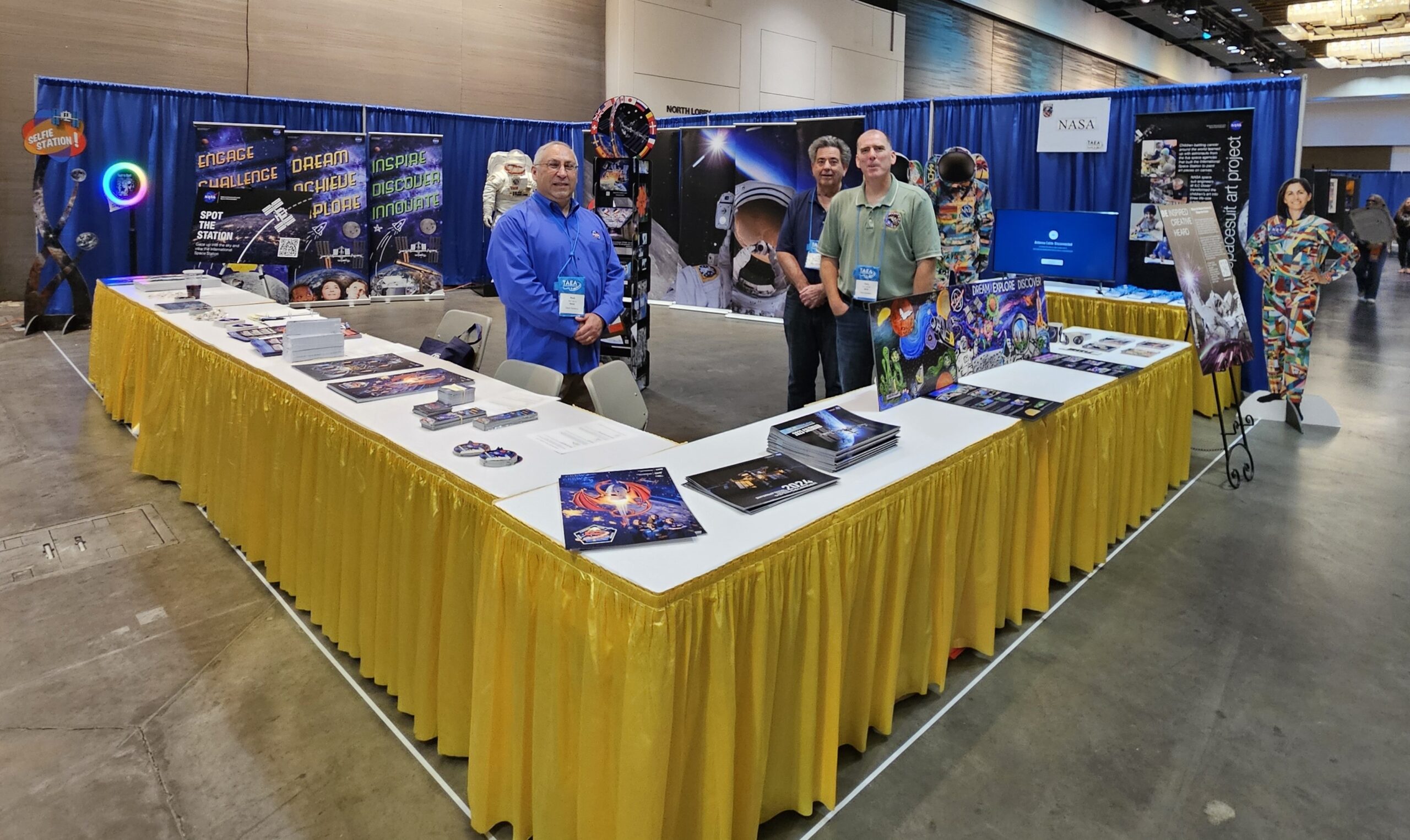The Texas Art Education Association hosted its annual conference from Nov. 14–16 at Moody Gardens Hotel & Convention Center in Galveston, Texas, drawing nearly 3,000 educators, administrators, and artists.
This year’s theme, “Cosmic Connections: SPACE, the Last Frontier and the Element of Art,” celebrated the fusion of creativity and space exploration, with NASA’s Johnson Space Center participating for the first time to inspire the Artemis Generation art educators.
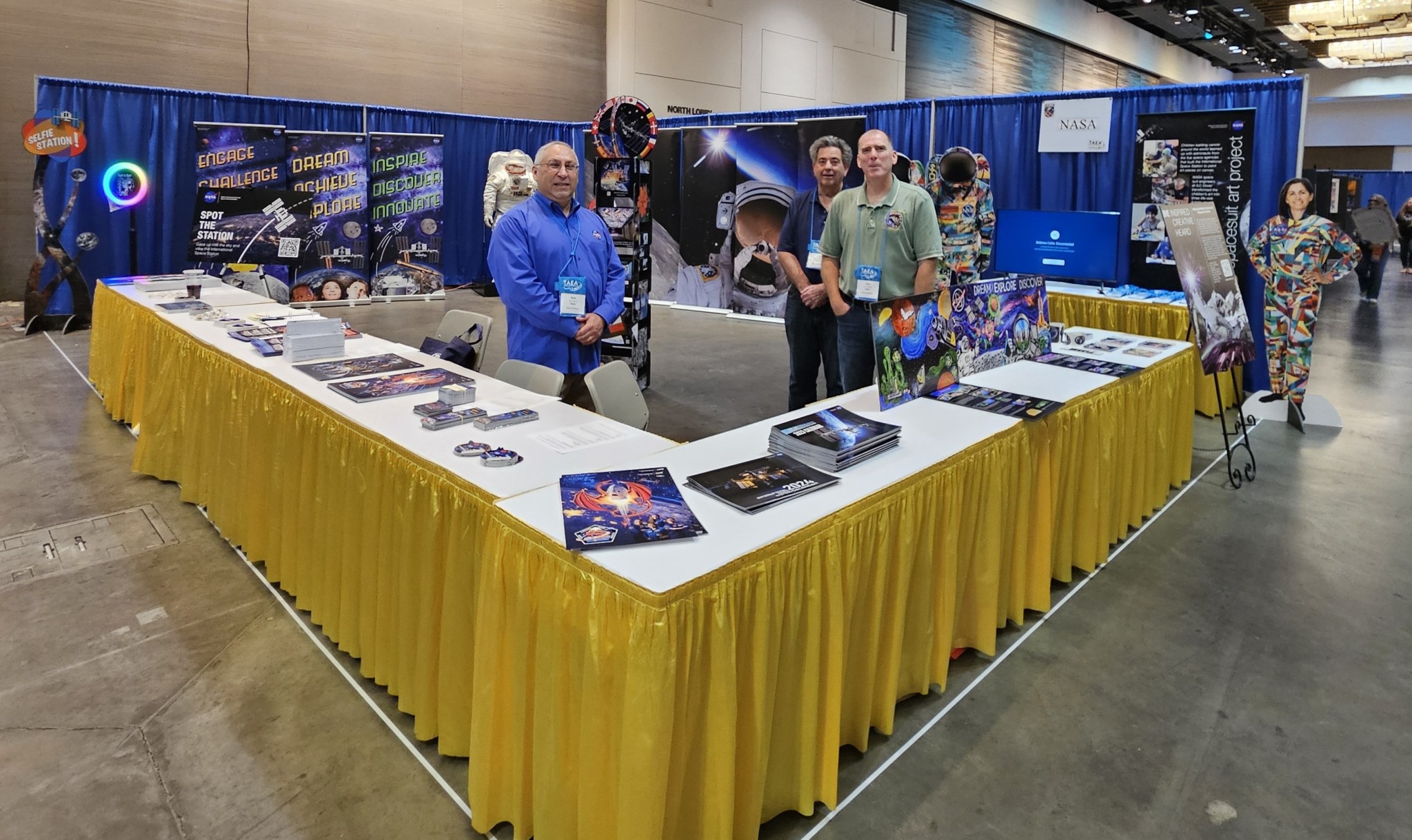 Johnson Space Center volunteers Raul Tijerina (left), building graphics lead for the International Space Station Program; Gary Johnson (middle), technical manager in NASA’s International Space Station Mission Integration and Operations Office; and Christian Getteau, Imagery Integration and Multimedia producer with the Human Space Flight Technical Integration Contract, participate in the NASA booth at the Texas Art Education Association annual conference held Nov. 14–16 at Moody Gardens Hotel & Convention Center in Galveston, Texas.NASA From astronauts crafting in orbit to collaborative art projects on Earth, NASA continues to showcase how creativity can capture the wonder of the cosmos. This event allowed educators to connect with NASA, explore teaching resources, and discover innovative ways to merge the arts with science and space exploration in their classrooms.
Johnson Space Center volunteers Raul Tijerina (left), building graphics lead for the International Space Station Program; Gary Johnson (middle), technical manager in NASA’s International Space Station Mission Integration and Operations Office; and Christian Getteau, Imagery Integration and Multimedia producer with the Human Space Flight Technical Integration Contract, participate in the NASA booth at the Texas Art Education Association annual conference held Nov. 14–16 at Moody Gardens Hotel & Convention Center in Galveston, Texas.NASA From astronauts crafting in orbit to collaborative art projects on Earth, NASA continues to showcase how creativity can capture the wonder of the cosmos. This event allowed educators to connect with NASA, explore teaching resources, and discover innovative ways to merge the arts with science and space exploration in their classrooms.
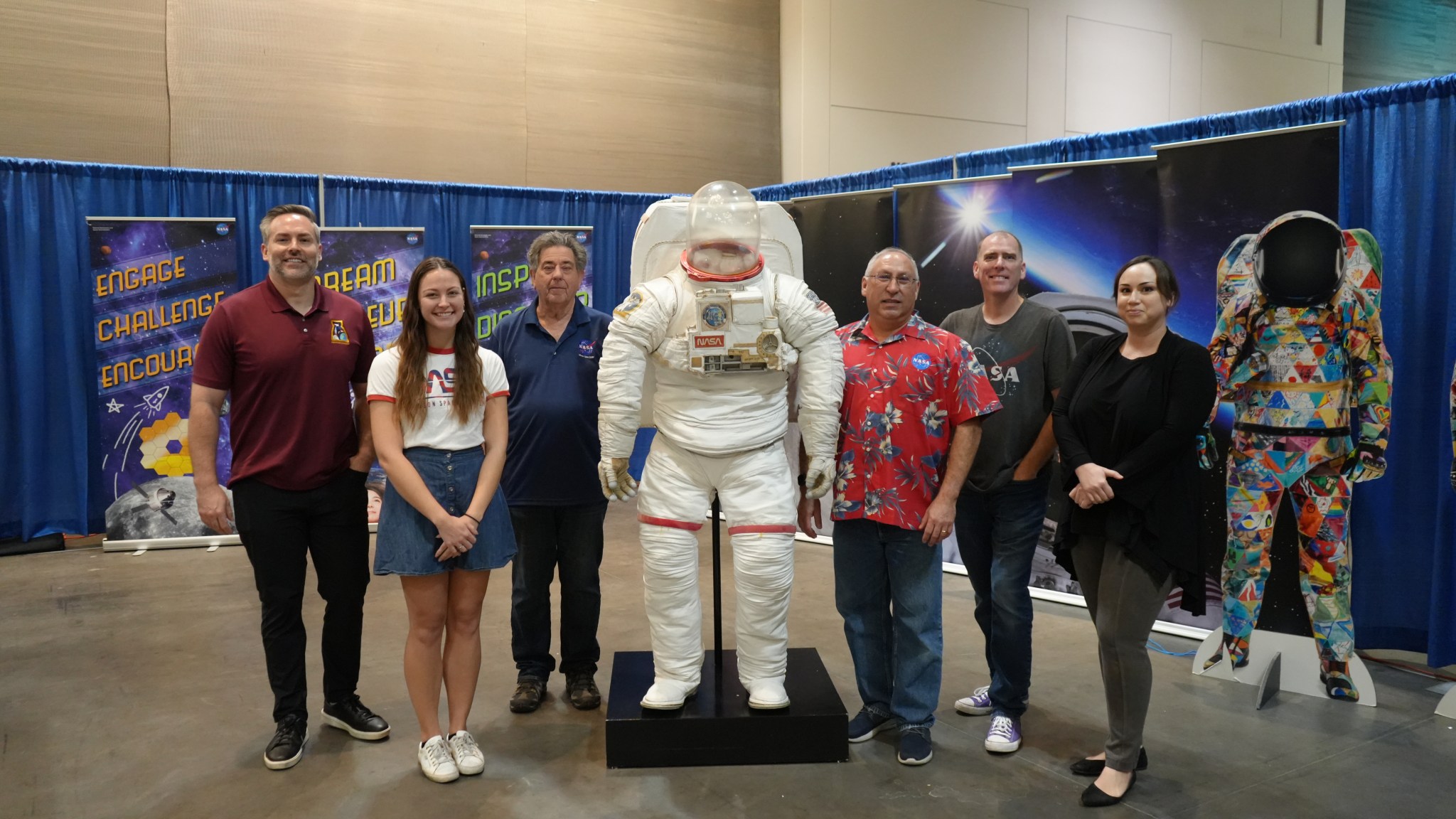 Johnson volunteers pose with an astronaut spacesuit at the Texas Art Education Association conference.NASA/Sumer Loggins “We have seen our astronauts bring the art of painting, music, photography, and more to orbit aboard the space shuttle and the International Space Station,” said Gary Johnson, NASA’s International Space Station Mission Integration and Operations Office technical manager. “Our mission is to inspire the next generation of artists and explorers to capture the beauty of space through any medium they choose.”
Johnson volunteers pose with an astronaut spacesuit at the Texas Art Education Association conference.NASA/Sumer Loggins “We have seen our astronauts bring the art of painting, music, photography, and more to orbit aboard the space shuttle and the International Space Station,” said Gary Johnson, NASA’s International Space Station Mission Integration and Operations Office technical manager. “Our mission is to inspire the next generation of artists and explorers to capture the beauty of space through any medium they choose.”
“Everyone has a place at NASA,” added Raul Tijerina, International Space Station Program building graphics lead. “This collaboration celebrates the diversity of talents needed to explore the universe, including those who bring ideas to life through art.”
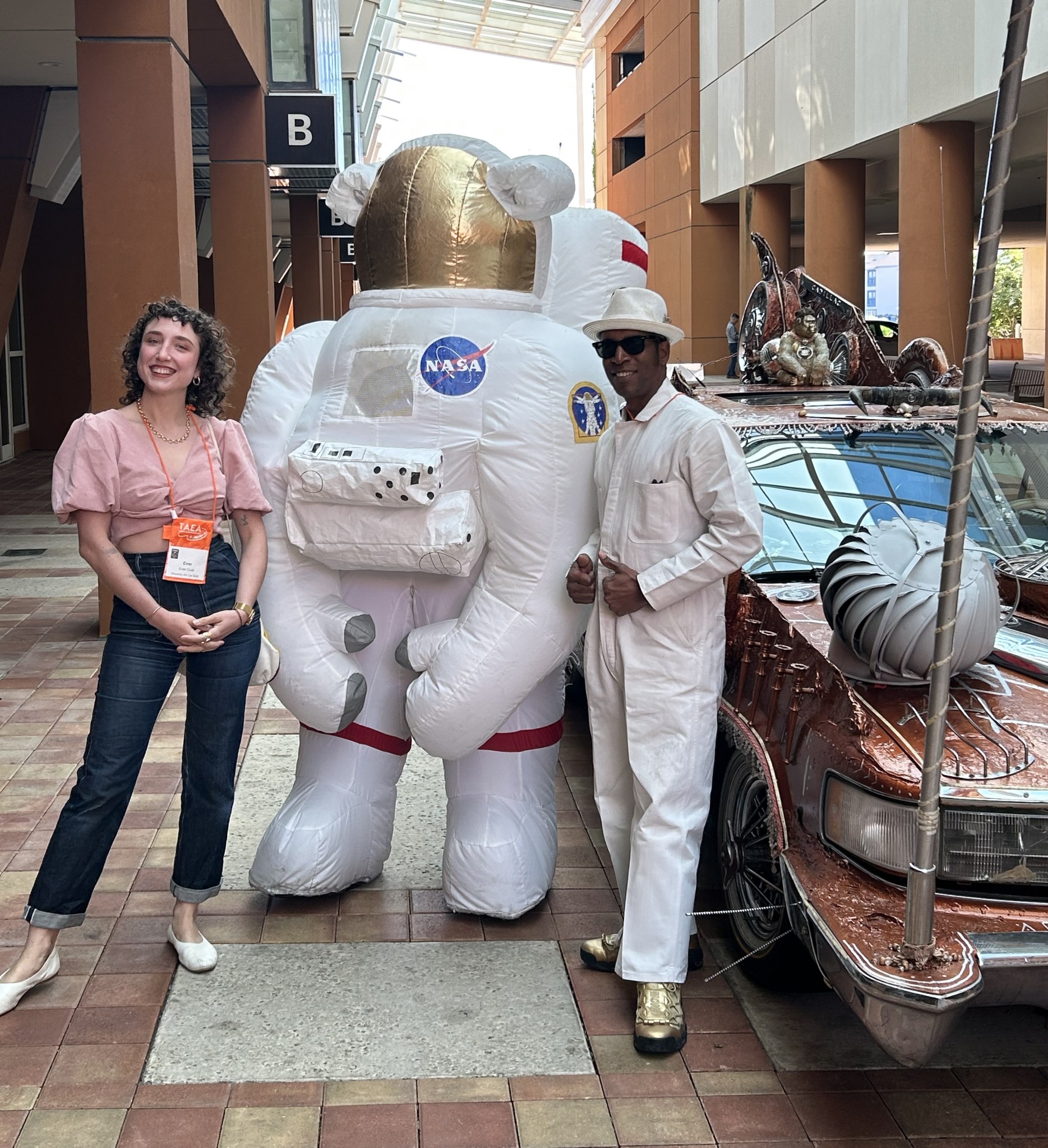 NASA’s inflatable mascot, Cosmo, greets attendees and poses for photos during the art car show at the conference. NASA Guests immersed themselves in a variety of stellar experiences, including interacting with NASA’s inflatable mascot, Cosmo, taking selfies at the NASA booth, and viewing artwork that shares the past and celebrates the future of space exploration.
NASA’s inflatable mascot, Cosmo, greets attendees and poses for photos during the art car show at the conference. NASA Guests immersed themselves in a variety of stellar experiences, including interacting with NASA’s inflatable mascot, Cosmo, taking selfies at the NASA booth, and viewing artwork that shares the past and celebrates the future of space exploration.
The nonprofit SciArt Exchange provided teachers with details about its space art competitions, aimed at sparking curiosity across all ages. These competitions include the Project Mars Competition, where adults compete to have their artwork featured at Johnson, and the Moon Youth Art Competition, which highlights lunar-themed creations from students around the world.
Attendees also explored infographics and had the chance to download NASA’s Spot the Station app to track the orbiting laboratory in real-time.
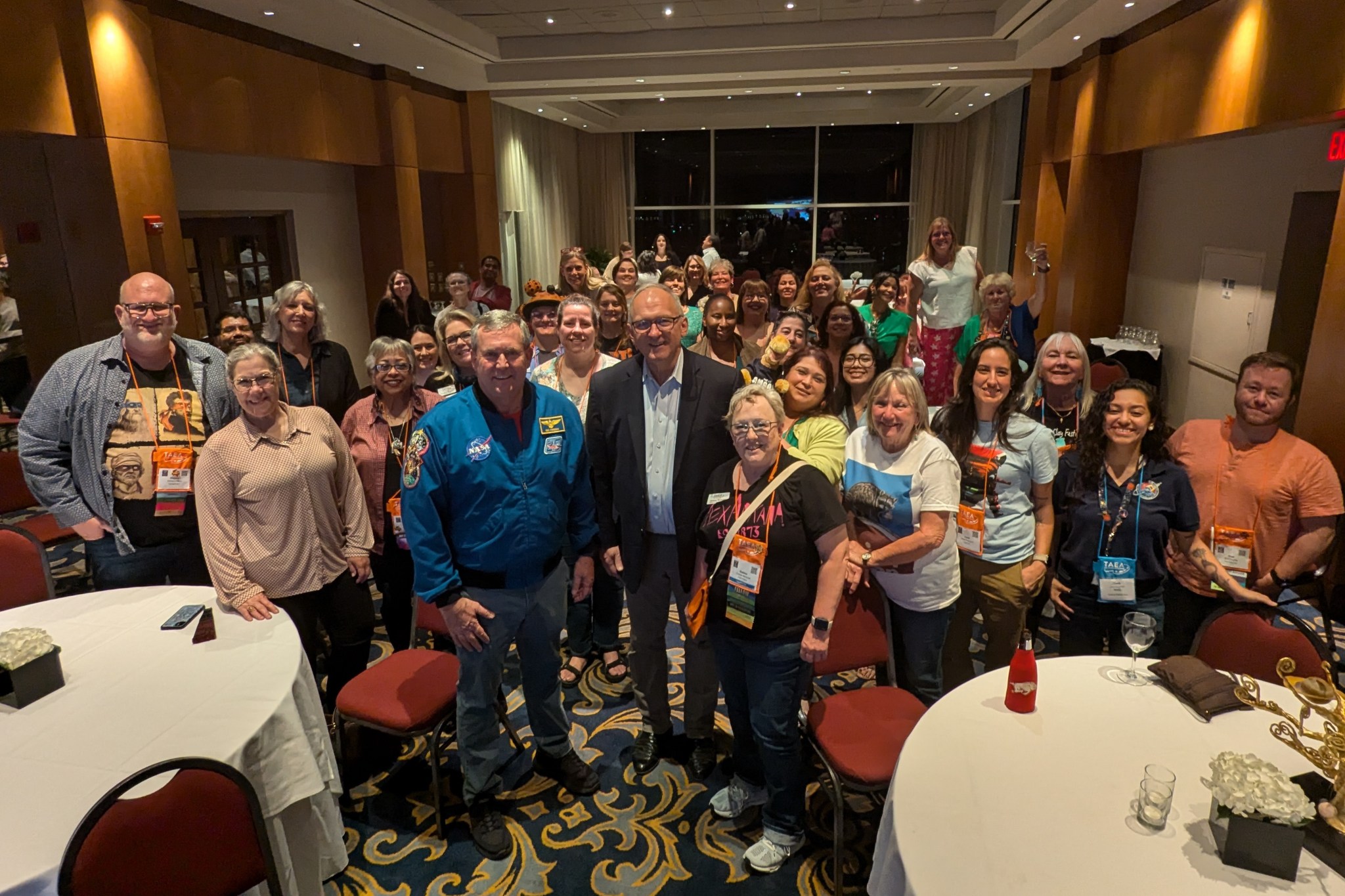 NASA astronaut Michael Foreman (middle left) and Gordon Andrews, a strategic communications specialist for the International Space Station Program, pose with attendees following a space-themed presentation.NASA Gordon Andrews, a strategic communications specialist for the International Space Station Program, and NASA astronaut Michael Foreman introduced the Spacesuit Art Project to conference attendees. They shared the documentary “Space for Art,” which chronicles the project’s mission to inspire hope, courage, and healing through art.
NASA astronaut Michael Foreman (middle left) and Gordon Andrews, a strategic communications specialist for the International Space Station Program, pose with attendees following a space-themed presentation.NASA Gordon Andrews, a strategic communications specialist for the International Space Station Program, and NASA astronaut Michael Foreman introduced the Spacesuit Art Project to conference attendees. They shared the documentary “Space for Art,” which chronicles the project’s mission to inspire hope, courage, and healing through art.
Andrews and Foreman discussed their experiences working on the project with retired NASA astronaut Nicole Stott, the first person to watercolor in space, and the Space for Art Foundation. Foreman shared stories from his time in space and posed for photos with guests. Andrews also presented to the Visual Art Administrators of Texas, a group of over 200 Texas education leaders.
The film played at NASA’s booth, showcasing how the initiative brings hope to children undergoing pediatric cancer treatment by inviting them to create colorful spacesuit artwork. Each suit—Hope, Courage, Unity, Victory, Dreamer, Exploration, Beyond, and Infinity—embodies the resilience and imagination of its creators. Four of these spacesuits have journeyed to and from the microgravity laboratory, inspiring children to dream big as they view their artwork in orbit.
By raising awareness about pediatric cancer and promoting art therapy worldwide, the project demonstrates the powerful connection between space exploration and the human spirit.
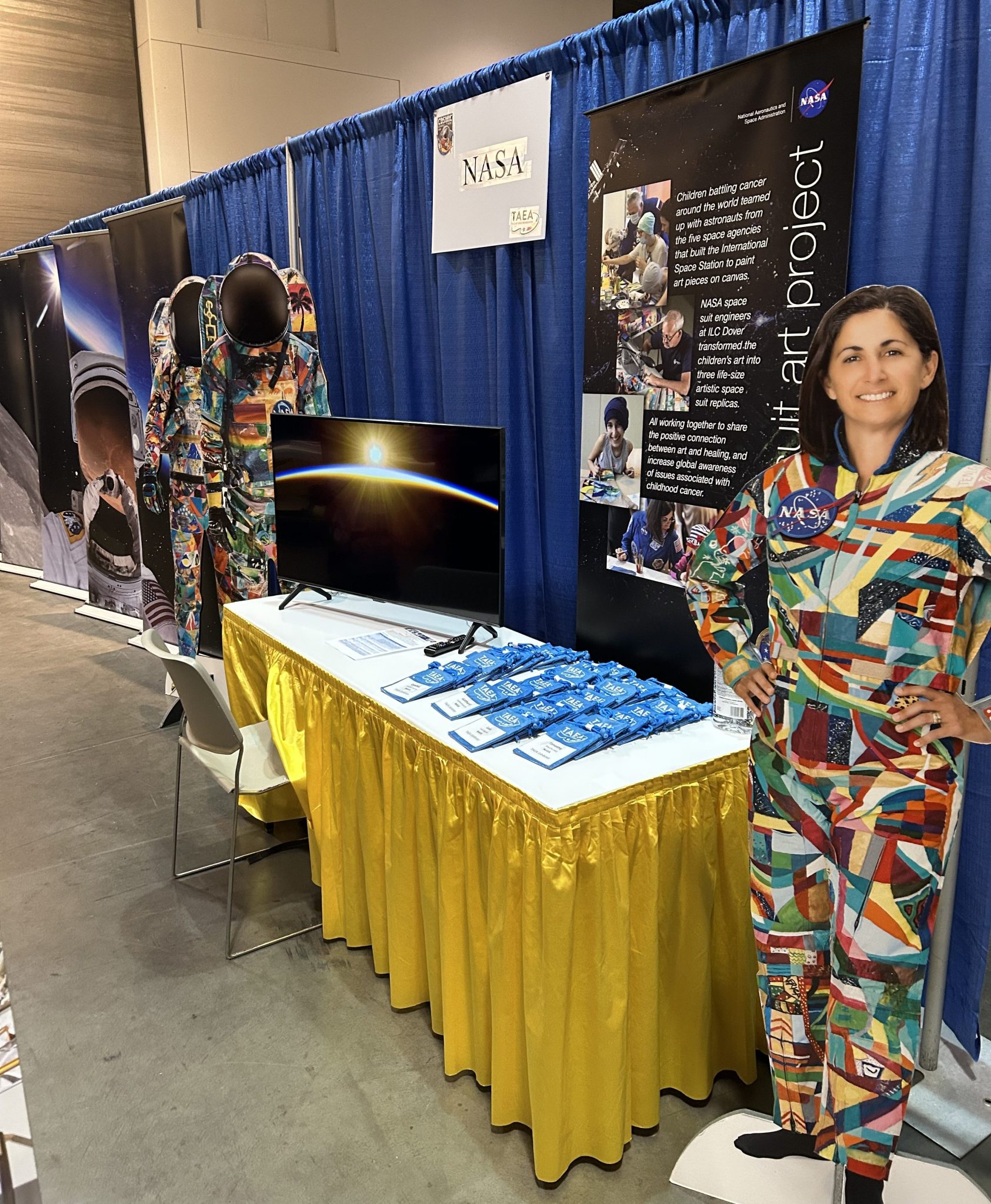
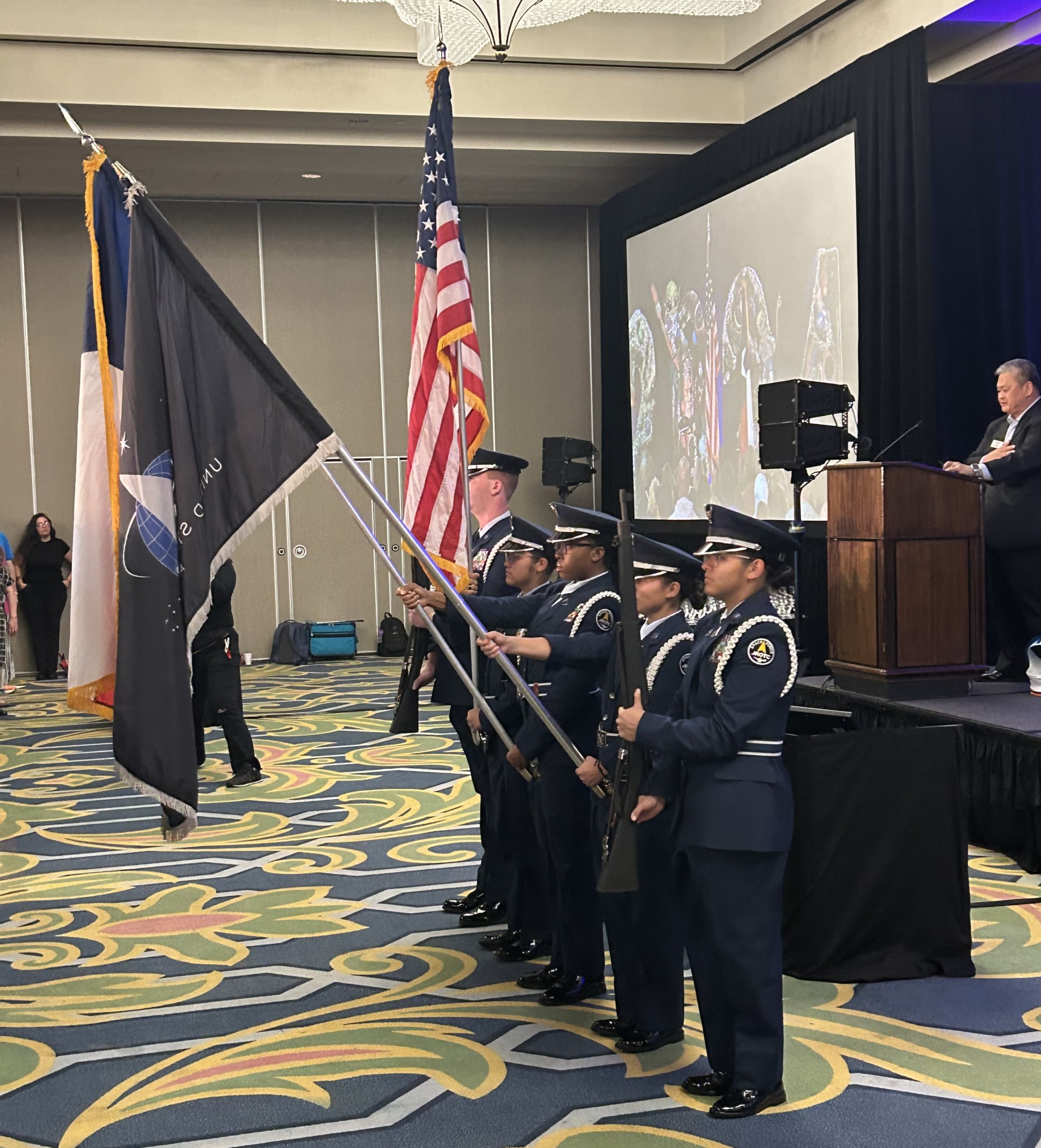 Texas’ first Space Force Junior Reserve Officers’ Training Corps cadets from Klein High School participate in the ceremony as a NASA rendition of the National Anthem plays in the background. NASA The conference also featured three murals that will be added to the art collection in Johnson’s building 4 south.
Texas’ first Space Force Junior Reserve Officers’ Training Corps cadets from Klein High School participate in the ceremony as a NASA rendition of the National Anthem plays in the background. NASA The conference also featured three murals that will be added to the art collection in Johnson’s building 4 south.
The art installation project began in 2022 when Johnson and Tijerina collaborated with Texas high school art programs to create space-themed murals for display at the center. With the help of their teachers, students brainstormed ideas and painted the murals together before visiting Johnson to install them and experience a guided walk-through of NASA’s facilities.
Led by their shared passion for artistic expression and space exploration, the students bring color, wonder, and creativity to the walls at Johnson. The initiative is part of a long-term effort to engage with students locally and globally to ignite the imagination of all and enhance the visual work environment for Johnson employees.
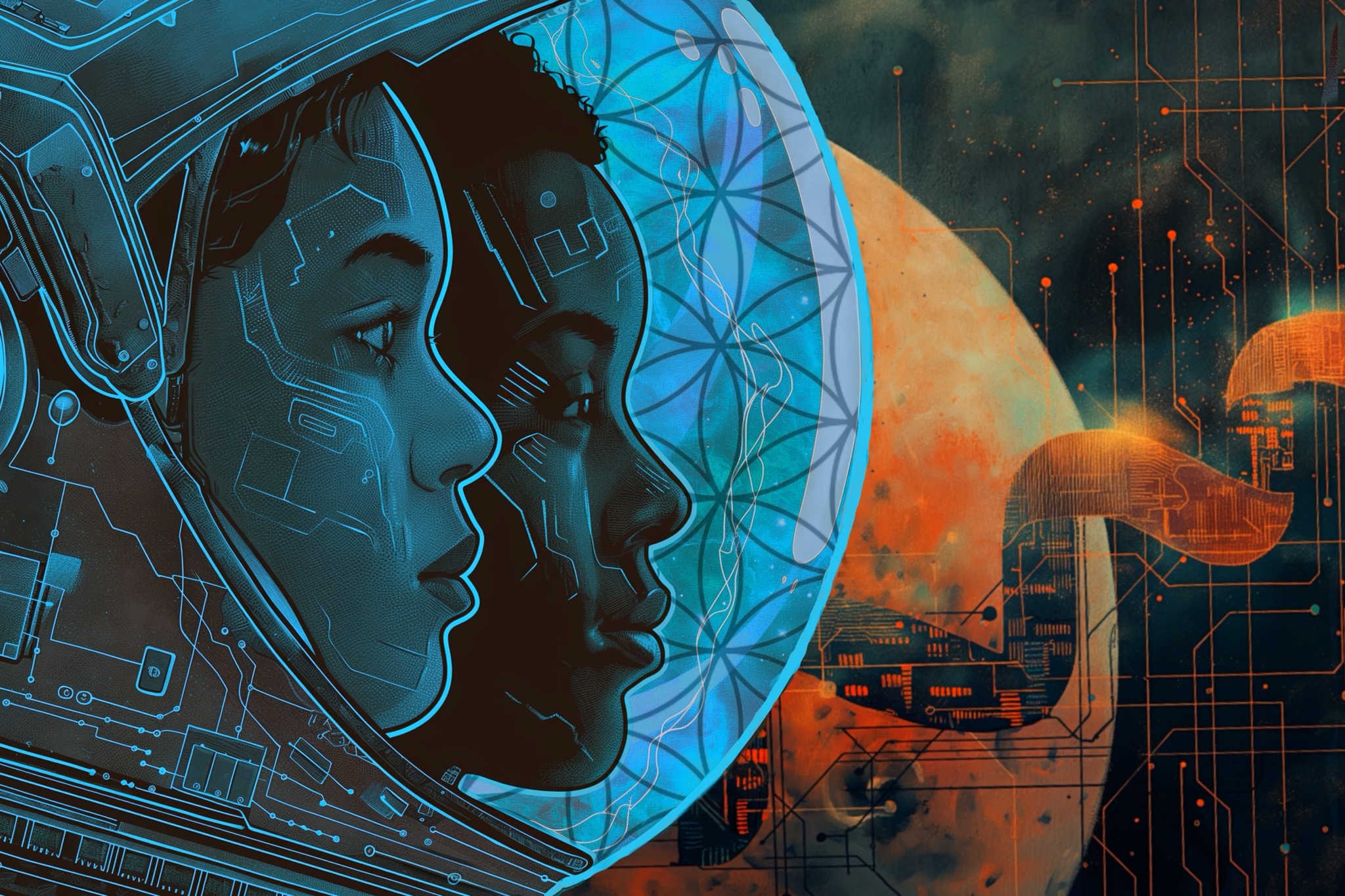 “Absolute Equality: Breaking Boundaries” by Reginald C. Adams, symbolizes unity and humanity’s collective future in space exploration. The artwork titled “Absolute Equality: Breaking Boundaries,” by artist Reginald C. Adams, will be one of the latest installations in building 4 south. The piece envisions humanity’s shared future, symbolizing unity and the possibilities of interplanetary exploration.
“Absolute Equality: Breaking Boundaries” by Reginald C. Adams, symbolizes unity and humanity’s collective future in space exploration. The artwork titled “Absolute Equality: Breaking Boundaries,” by artist Reginald C. Adams, will be one of the latest installations in building 4 south. The piece envisions humanity’s shared future, symbolizing unity and the possibilities of interplanetary exploration.
Adams was a keynote speaker for the conference, and when he learned about the mural project, he wanted to contribute to the initiative.
The two figures are enclosed within a shared helmet, representing a collective vision for the future of space exploration. The patterns surrounding them signify technology’s role in connecting humanity across cultural and societal divides.
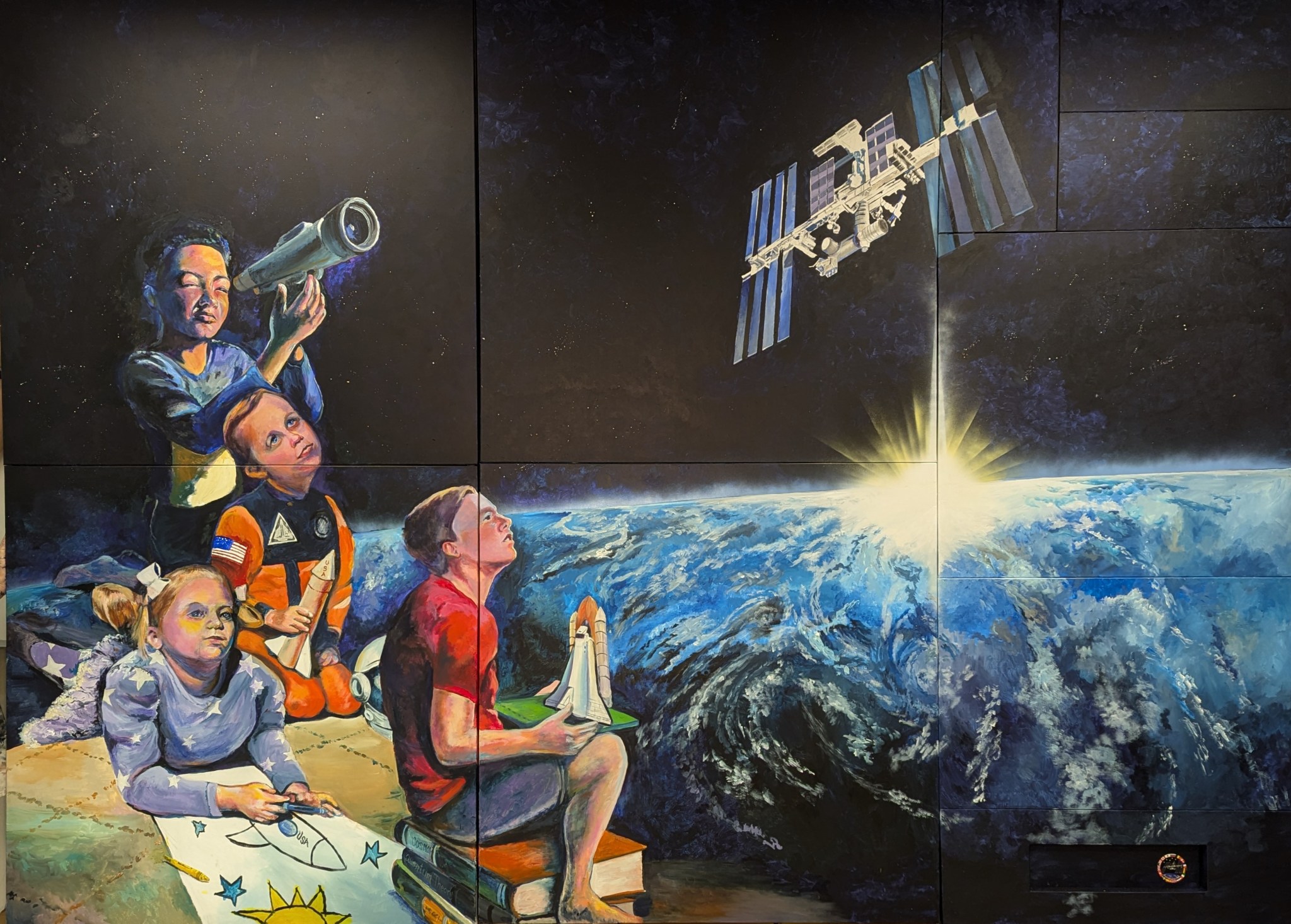 La Marque High School students, art teacher Joan Finn, and artist Cheryl Evans painted a mural highlighting the interconnected roles in space exploration. A collaborative piece by La Marque High School art students, art teacher Joan Finn, and artist Cheryl Evans depicted the interconnected roles of visionaries, engineers, artists, and astronauts in space exploration.
La Marque High School students, art teacher Joan Finn, and artist Cheryl Evans painted a mural highlighting the interconnected roles in space exploration. A collaborative piece by La Marque High School art students, art teacher Joan Finn, and artist Cheryl Evans depicted the interconnected roles of visionaries, engineers, artists, and astronauts in space exploration.
Just as the space station was assembled piece by piece over more than 40 missions, the mural was created using 10 separate stretched canvases bolted together. The International Space Station patch at the bottom highlights the collaboration of the 17 countries involved.
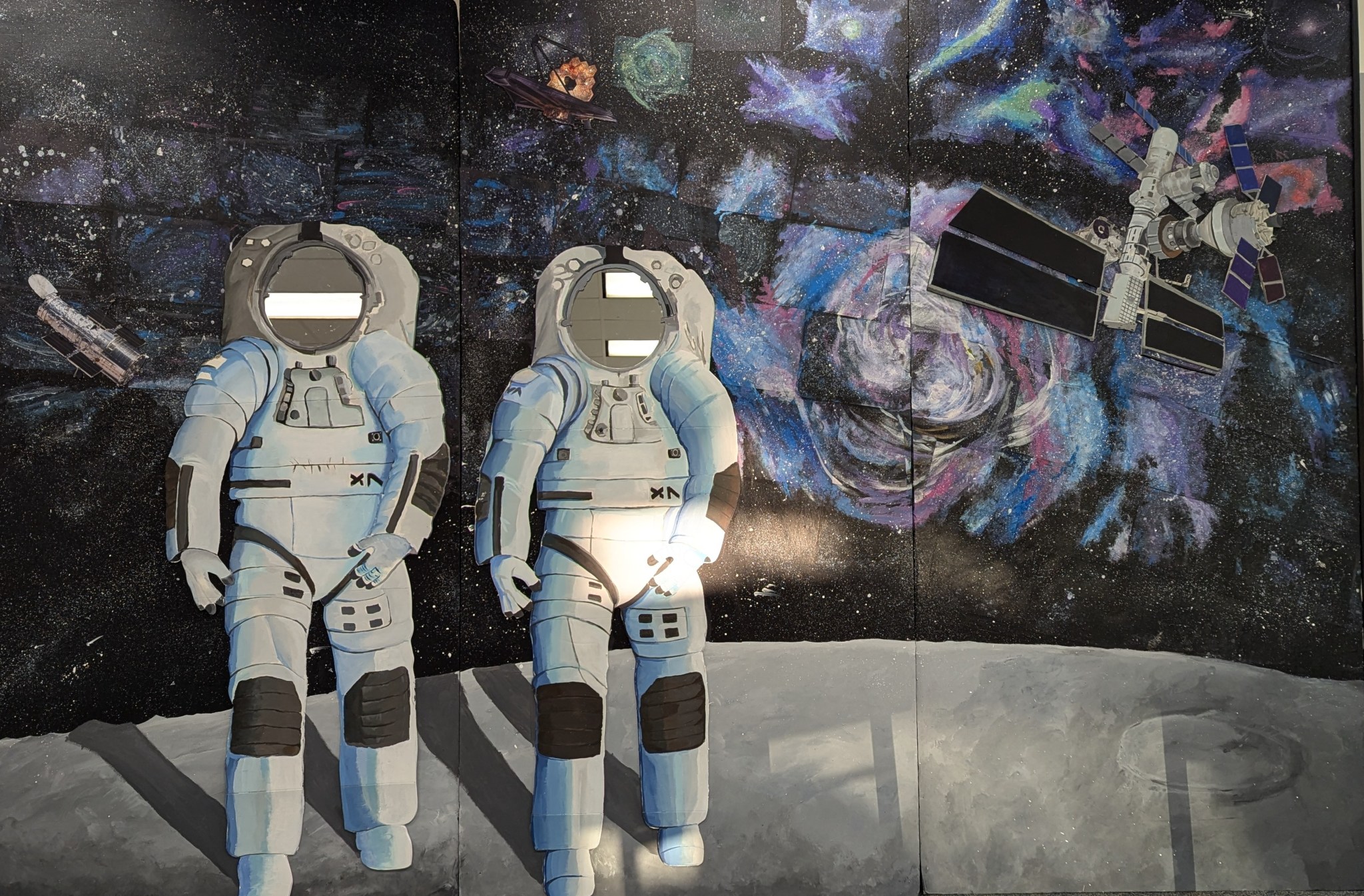 “The Moon Now,” created by La Marque High School students, depicts two astronauts on the lunar surface in Axiom spacesuits with mirrored visors. A student-created vision titled “The Moon Now” showcased two astronauts on the lunar surface wearing Axiom spacesuits, with helmet visors designed as mirrors, signifying the next generation to envision themselves contributing to the next giant leap in space exploration.
“The Moon Now,” created by La Marque High School students, depicts two astronauts on the lunar surface in Axiom spacesuits with mirrored visors. A student-created vision titled “The Moon Now” showcased two astronauts on the lunar surface wearing Axiom spacesuits, with helmet visors designed as mirrors, signifying the next generation to envision themselves contributing to the next giant leap in space exploration.
The students created individual pieces depicting the Milky Way and other astronomical objects, which were collaged onto the surface of the artwork.
Through partnerships like this, NASA continues to embrace STEAM—science, technology, engineering, art, and math—to empower the Artemis Generation to dare, unite, and explore.

